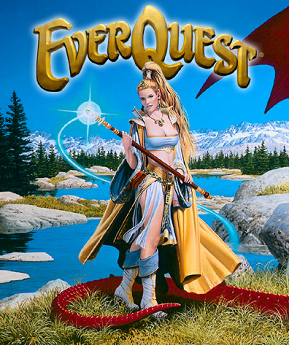
EverQuest is a 3D fantasy-themed massively multiplayer online role-playing game (MMORPG) originally developed by Verant Interactive and 989 Studios for Windows PCs. It was released by Sony Online Entertainment in March 1999 in North America, and by Ubisoft in Europe in April 2000. A dedicated version for Mac OS X was released in June 2003, which operated for ten years before being shut down in November 2013. In June 2000, Verant Interactive was absorbed into Sony Online Entertainment, who took over full development and publishing duties of the title. Later, in February 2015, SOE's parent corporation, Sony Computer Entertainment, sold the studio to investment company Columbus Nova and it was rebranded as Daybreak Game Company, which continues to develop and publish EverQuest.
A multi-user dungeon, also known as a multi-user dimension or multi-user domain, is a multiplayer real-time virtual world, usually text-based or storyboarded. MUDs combine elements of role-playing games, hack and slash, player versus player, interactive fiction, and online chat. Players can read or view descriptions of rooms, objects, other players, and non-player characters, and perform actions in the virtual world that are typically also described. Players typically interact with each other and the world by typing commands that resemble a natural language, as well as using a character typically called an avatar.
A massively multiplayer online role-playing game (MMORPG) is a video game that combines aspects of a role-playing video game and a massively multiplayer online game.

The 3DO Company, also known as 3DO, was an American video game company. It was founded in 1991 by Electronic Arts founder Trip Hawkins, in a partnership with seven other companies. After 3DO's flagship video game console, the 3DO Interactive Multiplayer, failed in the marketplace, the company exited the hardware business and became a third-party video game developer. It went bankrupt in 2003 due to poor sales of its games. Its headquarters were in Redwood City, California, in the San Francisco Bay Area.

Ultima Online (UO) is a fantasy massively multiplayer online role-playing game (MMORPG) released on September 24, 1997 by Origin Systems.
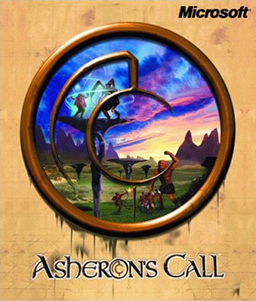
Asheron's Call (AC) was a fantasy massively multiplayer online role-playing game (MMORPG) for Microsoft Windows PCs, developed and published by Turbine Entertainment Software. Though it was developed by the Turbine team, it was published as a Microsoft title until 2004. The game was set on the island continent of Dereth and several surrounding smaller islands and archipelagos on the fictional planet of Auberean. The game was played in a large seamless 3D virtual world which could host thousands of players' characters at a time.
Twinking is a type of behavior in role-playing games that is disapproved of by other players. A player who engages in such behavior is known as a twink. The precise definition of twinking varies depending on the variety of role-playing game:
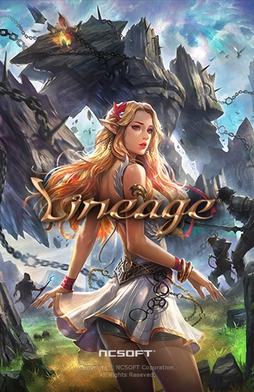
Lineage, also known as Lineage: The Blood Pledge in Western markets, is a medieval fantasy, massively multiplayer online role-playing game (MMORPG) released in Korea and the United States in 1998 by the South Korean computer game developer NCSoft, based on a Korean comic book series of the same name. It is the first game in the Lineage series. It is most popular in Korea and is available in Chinese, Japanese, and English. The game was designed by Jake Song, who had previously designed Nexus: The Kingdom of the Winds, another MMORPG.
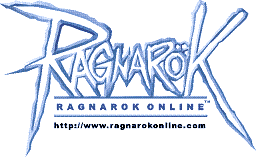
Ragnarok Online is a massive multiplayer online role-playing game (MMORPG) created by Gravity based on the manhwa Ragnarok by Lee Myung-jin. It was released in South Korea on 31 August 2002 for Microsoft Windows and in the Philippines where it became hit among Filipino Millennials. The game has spawned an animated series, Ragnarok the Animation, and a sequel game, Ragnarok Online 2: Legend of the Second. The player's characters exists in a world with a player environment that includes NPC's that can be interacted with, monsters spawning in maps that needs to be defeated to level-up and to acquire items, continuous updates includes changes with the passage of time based on real world like day and night and weather and game patches included culture from different nations, one of which is the Malaya Patch in 2007 which is based on the Philippine islands and includes Poring variation or skin, Nurse Poring. Major changes in the features and history of the world take place as episodes in the RO timeline. Ragnarok is heavily influenced by Blizzard's Warcraft (1995) which is an RPG or role-playing game and have multiplayer mode which subsequently developed into a 5V5 Player Battle Arena in the form of League of Legends. It is also based on Norse and Scandinavian Mythology and its name itself is based on an event in the final days where Gods will battle evil like the Apocalypse in the Bible. Ragnarok similarly in Apocalypse means the destruction of the world or Midgard in Nordic era which is believed to be a mythology up until now.
A massively multiplayer online game is an online video game with a large number of players to interact in the same online game world. MMOs usually feature a huge, persistent open world, although there are games that differ. These games can be found for most network-capable platforms, including the personal computer, video game console, or smartphones and other mobile devices.
Player versus player (PVP) is a type of multiplayer interactive conflict within a game between human players. This is often compared to player versus environment (PvE), in which the game itself controls its players' opponents. The terms are most often used in games where both activities exist, particularly MMORPGs, MUDs, and other role-playing video games, to distinguish between gamemodes. PvP can be broadly used to describe any game, or aspect of a game, where players compete against each other. PvP is often controversial when used in role-playing games. In most cases, there are vast differences in abilities between players. PvP can even encourage experienced players to immediately attack and kill inexperienced players. PvP is often referred to as player killing in the cases of games which contain, but do not focus on, such interaction.
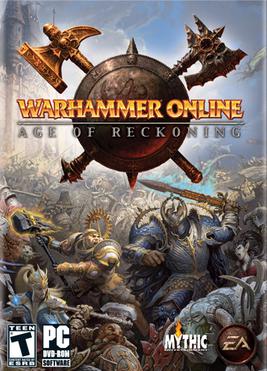
Warhammer Online: Age of Reckoning was a massively multiplayer online role-playing game based on Games Workshop's Warhammer Fantasy setting, developed by Mythic Entertainment and published by Electronic Arts in 2008. The game revolved around the continual worldwide conflict that the Warhammer Fantasy setting is known for, and the game is geared toward ongoing, constant war laced with dark humour. Age of Reckoning ended up selling over a million copies and peaking at 800,000 subscribers, but dropped to 300,000 subscribers several months later. The game received generally positive reviews from critics but shut down in 2013. Since at least 2014, an active private server called Return of Reckoning has been run by fans, and it remains active as of June 2024.
Tibia is a multiplayer online role-playing game (MMORPG) released in 1997, developed and published by CipSoft. It is one of the earliest and longest-running MMORPGs, reaching its peak popularity in 2007. The game is free to play but players may pay to upgrade to a premium account. Tibia is a two-dimensional tile-based game set in a fantasy world with pixel art graphics and a top-down perspective.
A griefer or bad-faith player is a player in a multiplayer video game who deliberately and intentionally irritates, annoys or trolls other players within the game. Griefing is often accomplished by destroying things constructed by other players or stealing items. A griefer derives pleasure from the act of annoying other users, and as such, is a nuisance in online gaming communities.
In role-playing games, an alternate character, often referred to in slang as alt, alt char, or less commonly multi, is a character in addition to one's "primary" or "main" player character. Players are generally not secretive about their alternate characters, unless having multiple characters is against the rules of the game, or in a role-playing environment where alternate characters might be judged by the actions of the primary character. In games where multiple characters are disallowed, enforcement of this restriction can be difficult, especially without specialized tools.

Brian "Psychochild" Green was an American software engineer, game developer and game designer known for his work on one of the first 3D, MMORPG's in existence, Meridian 59. Operated now by Open Source volunteers, the Meridian 59 servers continue operation after more than nearly twenty-five years.
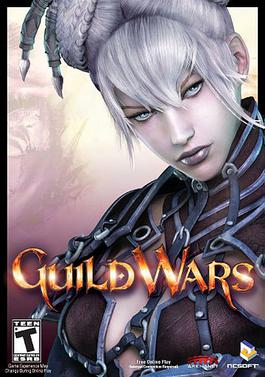
Guild Wars is a multiplayer online action role-playing game developed by ArenaNet, a subsidiary of South Korean game publisher NCSOFT, and released in 2005. As the original installment of the Guild Wars series, its campaign was retroactively titled Prophecies to differentiate it from the content of subsequent releases. The game contains a co-operative role-playing portion and a competitive Player versus Player (PvP) portion. In PvP, players may use either their co-operative characters or PvP-exclusive characters who are inherently maximum level and have account-based access to unlocked content.
The history of massively multiplayer online games spans over thirty years and hundreds of massively multiplayer online games (MMOG) titles. The origin and influence on MMO games stems from MUDs, Dungeons & Dragons (D&D) and earlier social games.
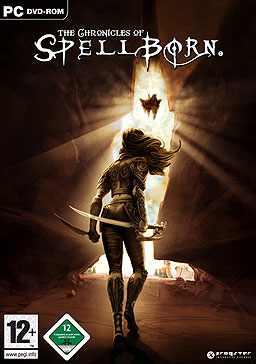
The Chronicles of Spellborn was a massively multiplayer online role-playing game (MMORPG) initially released on November 27, 2008, developed by Spellborn International and distributed by Frogster Interactive, Mindscape and Acclaim Games; set in a post-apocalyptic fantasy world. Spellborn used the Unreal Engine, featured a European Art approach and contained notable contributions from Jesper Kyd. In August 2010, the game was shut down. As of 2019, the game is still played on a proprietary private server that is operated by a former developer.

Dark Sun Online: Crimson Sands was an early massively multiplayer online role-playing game (MMORPG) that was developed and published by Strategic Simulations, Inc. in 1996 for Windows 95. Dark Sun Online was based on the licensed Dark Sun campaign setting for the Advanced Dungeons & Dragons tabletop role-playing game. It was one of the first fully graphical MMORPGs.











